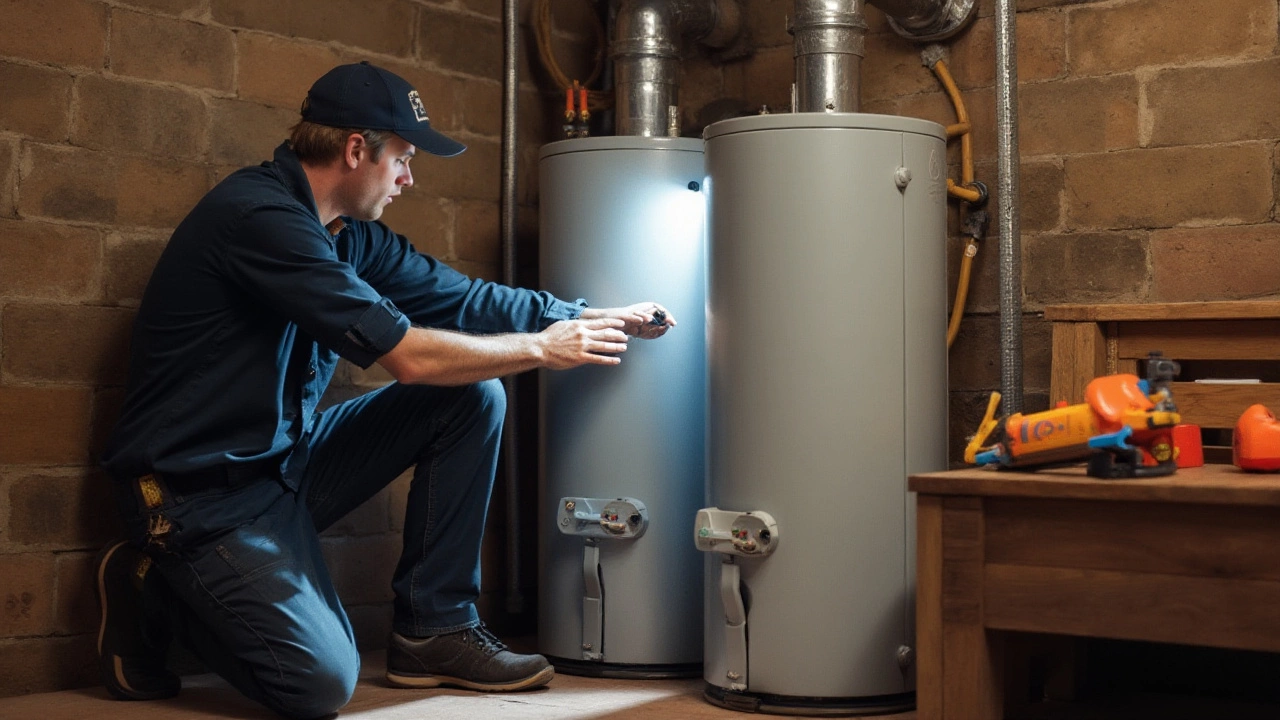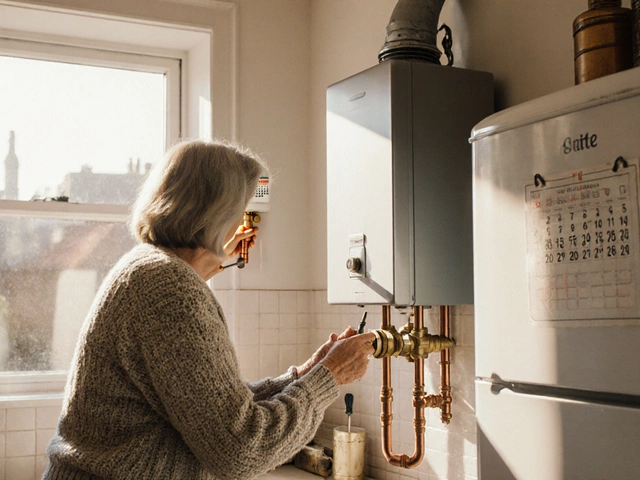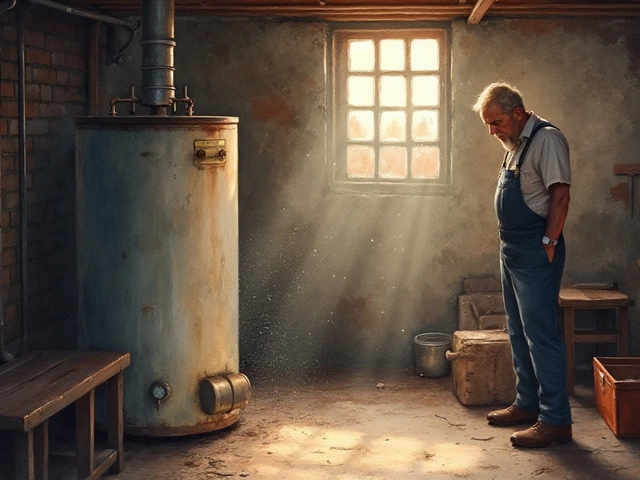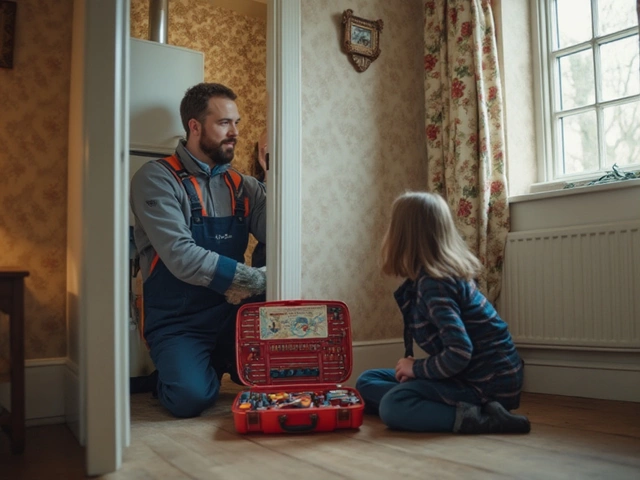Ensuring your water heater is in top working condition is crucial for comfort and efficiency in your home. The cozy warmth of a hot shower is something you don't want to miss, especially with a brisk Adelaide winter in the picture. But how do you check if your water heater is doing its job right? Knowing the signs of a performing or faulty heater can save you from unexpected cold showers and high repair bills.
This article will discuss the essential tips and practical steps to verify that your water heater is warming up your home efficiently. From identifying common issues to conducting simple tests and understanding when to call in the experts, you'll be guided through practical measures to keep your water heater in peak condition. Let's dive into what makes your water heater tick and how you can ensure it stays reliable day after day.
- Signs of a Malfunctioning Water Heater
- Simple Tests You Can Perform
- Regular Maintenance Tips
- When to Contact a Professional
- Preventive Measures for Longevity
Signs of a Malfunctioning Water Heater
Ever been caught off guard by a sudden blast of icy water during your shower? These unpleasant surprises may signal that your water heater needs some attention. Recognizing these signs early on can prevent small issues from snowballing into expensive repairs. The most glaring sign of an ailing heater is a lack of consistent hot water. If your once steaming showers have turned lukewarm or cold, your heater may not be working efficiently. It might come down to the pilot light going out, a faulty thermostat, or sediment buildup inside the tank.
Beyond temperature inconsistencies, listen closely for unusual noises. Heaters often emit strange sounds when they're on the fritz. Rumbling, banging or popping noises often are sediment-related problems. Over time, sediments settle at the bottom of your tank, hardening due to heat and causing the heater to use extra energy. This can make it less efficient and strain the unit, potentially leading to damage. Paying attention to such auditory signs can help diagnose issues before they become severe.
Look around for any visible leaks or pooling water near your unit. Water leaking from the heater is a clear indication of trouble. Leaks can occur from the tank or connections and may signify structural faults, corrosion, or damage that needs immediate repair. Any delay can lead to extensive water damage or potential flooding. Consequential repairs can quickly become costly, not to mention the risk of electrical hazards if the water spreads.
Heater maintenance is crucial, so keep an eye on your water heater's age. Most heaters last between 8 to 12 years, but if yours is nearing the end of its lifespan, poor performance might be a natural sign of aging. Replacement could be more cost-effective than continuous repairs. Check the serial number plate to figure out your heater’s age and make the necessary plans. If it's ancient by any standards, it may be due for an upgrade to keep your home warm and water hot.
Sudden changes in water quality might also arise from a struggling heater. If rust flakes or chunks come from your taps, it can indicate rusting inside the water heater or the pipes. This is common in older models, but quick action will keep additional costs at bay and enhance water safety. Rusty water or a metallic taste can forewarn of internal corrosion, demanding inspection and likely intervention. A dependable heater should deliver clean and reliable hot water without alteration of its quality.
"Neglecting water heater maintenance not only impacts efficiency but also compromises home safety," says James R. Salazar, an expert at HomeEnergy Magazine.
Couple these signs with temperature fluctuation, strange sounds, leakage, and murky water, and you have got a crystal-clear picture of why regular maintenance and prompt action matter in your home.
| Signs | Possible Issues |
|---|---|
| Temperature Fluctuations | Pilot Light Out, Faulty Thermostat |
| Strange Noises | Sediment Buildup |
| Leaks | Structural Damage, Corrosion |
| Rusty Water | Internal Corrosion |
Simple Tests You Can Perform
When it comes to verifying if your water heater is functioning correctly, performing a few simple tests can give you peace of mind and save on technical consultations. First, observe and listen. Start by approaching your heater. Is there any unusual noise—a pop or a hiss? Often, these sounds suggest sediment buildup, which is a common issue, especially in Adelaide's hard water areas. Sediment can affect heater efficiency and may need your attention.
Next, check the hot water temperature. Turn on a tap and allow it to run for a while. Measure the water temperature with a waterproof thermometer. Ideally, the temperature should hover between 120 to 140 degrees Fahrenheit. Anything lower might indicate a problem with the heating element, while higher could suggest an error in the thermostat setting, risking scalds or additional energy costs.
Visual Inspection and Leak Check
Another fundamental test involves a thorough visual examination of the heater. Check all visible components and joints for signs of leaks or corrosion. Water pooling around the base or rust marks often signals an issue requiring immediate attention. An interesting fact to consider is that it's suggested by the International Association of Certified Home Inspectors"even a small amount of water can lead to significant damage and costly repairs over time."Doing this inspection periodically can help catch issues early before they spiral into bigger problems.
To delve deeper, examine the pilot flame (for gas heaters) or reset the circuit breaker (for electric heaters). Modern gas heaters often come with a sight glass that allows you to see the pilot flame. A healthy flame is bright blue, with a small touch of yellow at the tip. If it is mostly yellow, it may need a clean-up or adjustment. If your heater is electric, ensure the breaker hasn’t tripped, keeping the thermostat and heating elements from working.
T&P Valve and Its Importance
Pay special attention to the Temperature and Pressure Relief (T&P) valve test. This safety device helps prevent water heater explosions by releasing pressure if it becomes too high. To test, look for the valve on the side or top of your heater. Lift the lever slightly and listen for the sound of water or a slight hiss as water is released. A properly functioning valve should easily reset when you release it. If no water is released, or it does not reset, it might need replacement, which typically requires professional handling.Performing a Sediment Flush
Lastly, consider performing a simple sediment flush at least once a year. This procedure involves attaching a garden hose to the drain valve and discharging the water till it runs clear. Not only does this prevent build-up, but it ensures your heater operates efficiently mile after mile. Removing debris from heating elements helps reduce noise, and improve performance, and it may even extend your heater’s life span.By following these simple tests, anyone can ensure their water heater operates under optimal conditions. These checks help you take preventive action and alert you when professional help is necessary, maintaining comfort and safety within the home.

Regular Maintenance Tips
Regular maintenance can significantly extend the life of your water heater, ensuring that it operates effectively and safely. Neglecting maintenance not only shortens the lifespan of your heater but can also lead to costly repairs. One essential task is to regularly inspect your heater for leaks. Even small leaks can indicate larger problems, such as internal rust or pressure issues. Ensure that the area around your heater is dry, and check all visible pipes and connections for any signs of moisture.
Flushing your water heater tank is another crucial maintenance step. Sediment buildup inside the tank can not only reduce the efficiency of your heater but also lead to corrosion and rapid deterioration. It is recommended to perform a complete flush of the tank at least once a year. To do this, turn off the power supply to the heater and connect a garden hose to the drain valve. Open the valve and allow the water to flow out until it runs clear of sediment. This simple step can make a big difference in the longevity and performance of your system.
Important to consider is the temperature setting of your heater. While it may be tempting to set it high for hotter showers, keeping the thermostat at a moderate setting not only saves energy but also protects the heating elements from unnecessary stress. Most experts suggest maintaining the temperature at around 120 degrees Fahrenheit (about 49 degrees Celsius) for optimal performance and safety. This reduces the risk of scalding and prevents the heater from working harder than needed, which can help lower energy bills as well.
Inspecting the anode rod is also a preventative measure often overlooked. The anode rod is a crucial component that attracts corrosive elements in the water, protecting the tank from rust. Over time, the rod deteriorates and needs replacement—typically, every three to five years, depending on water quality and usage. To check it, first turn off the power and water supply, then remove the rod with a socket. If it has worn down to less than half an inch or is coated in calcium deposits, it’s time for a replacement.
A well-maintained water heater not only prolongs its lifespan but also maintains efficiency and safety. As famed inventor Thomas Edison once noted, "The reason a lot of people do not recognize opportunity is because it usually goes around wearing overalls looking like hard work." Indeed, while regular maintenance may seem tedious at times, the long-term benefits far outweigh the efforts involved. Consistency in these practices ensures that your water heater remains a reliable part of your home, ready to provide comfort at a moment's notice.
Lastly, it's good to keep an eye on modern technology that allows smart maintenance alerts for your water heater system. Many new models come equipped with wifi capabilities and companion apps that send you alerts when maintenance is due or if a problem is detected. This forward-thinking feature helps ensure you stay ahead of potential issues, so your system continues to run efficiently. Ultimately, a modest investment of time and effort in regular maintenance translates into peace of mind and steady hot water supply day in and day out.
When to Contact a Professional
While it's empowering to handle minor water heater issues on your own, some situations demand the expertise of a professional. Identifying these moments can be crucial in avoiding costly damages or even hazardous conditions in your home. If you're experiencing consistent hot water shortages without any clear reason, like a drain valve issue, it's probably time to call someone who knows their way around a water heater. Persistent lack of hot water might indicate a problem with the thermostat, which is not always a straightforward fix and requires specialized tools and knowledge to address.
Another red flag is when you observe a rumbling or strange noise emanating from your water heater. This could signify sediment buildup inside the tank, a problem that, if unchecked, can lead to reduced efficiency or even failure of the unit. Professional plumbers have the right equipment to flush out the tank safely. In some cases, when there's a visible leak or pooling water around the unit, this could suggest a more severe failure of either the tank or its connection points.
Engaging a licensed technician is also advisable when the unit is visibly rusting, especially around the temperature and pressure relief valve. Rust is often a harbinger of more severe corrosion, which can compromise the entire system integrity. According to a report by the Australian Institute of Refrigeration, Air conditioning and Heating, “Regular professional check-ups can extend the life of your water heater significantly, sometimes by as much as 25%.”
Sometimes, the expertise required isn't just about hands-on repair. Water heaters, often using high voltage, pose significant safety risks if not handled correctly. If you're unsure about working with electricity or unfamiliar with the plumbing layout in an Adelaide home, it's prudent to hire a professional. Doing so ensures compliance with local safety standards and regulations, avoiding potential hazards you might not foresee.
Lastly, consider the age of your unit. If your water heater is beyond ten years old and requires frequent repairs, investing in a new model might be a cost-effective and energy-efficient alternative in the long run. A professional can help to evaluate whether replacement is the best course of action based on your specific needs and usage habits. By knowing when to call a professional, you not only save yourself from future headaches but also ensure that you maintain a constant supply of hot water when you need it.

Preventive Measures for Longevity
A well-maintained water heater can offer many years of reliable service, and a bit of routine attention can go a long way in prolonging its lifespan. Start with inspecting the temperature setting. Most water heaters perform optimally at around 120 degrees Fahrenheit (approximately 49 degrees Celsius), which not only prevents scalding but also reduces energy consumption. Maintaining the right temperature lessens the strain on the heater, ultimately affecting its durability and performance positively.
Another important preventive measure is draining your water heater at least once a year to remove sediment build-up. Sediment collects over time and can insulate water from the heat source, which makes the heater work harder and shortens its lifespan. To drain it, turn the heater off, attach a hose to the drain valve, and let the water flow out until clear. These simple steps can save on repairs and ensure an uninterrupted supply of hot water.
Regular maintenance should also include checking the anode rod, a crucial component that prevents rust formation. Ideally, this rod should be inspected every three years. If the anode rod is consumed or coated with calcium, it’s advisable to replace it to avoid rusting, which can inflict irreversible damage to your heater’s tank. Using a good quality anode rod not only extends the life of the heater but keeps your water free from metallic tastes or debris.
Your annual maintenance routine should also focus on the pressure relief valve. This safety device prevents excessive pressure inside the tank by releasing water. To check it's working correctly, simply lift the lever, allowing it to snap back in place. If water doesn’t flow when the lever is lifted, it might be time to replace the valve.
Proper insulation wraps can also make a difference. Especially in older models, insulating the pipes and the tank itself can save energy. It's an effective way to ensure that heating efficiency is retained during those cold winter months. Wrap the heater with a water heater blanket if it's in an unheated area, ensuring no segment is left exposed.
"Regular maintenance not only helps prolong the lifespan of equipment but also maintains efficiency and can lead to substantial energy savings," says David F. Vachon, an energy efficiency expert.
Finally, though it might seem minor, keeping an eye on your heater and understanding its sounds can alert you to potential issues before they escalate to costly repairs. Listening for alarming noises such as popping sounds is vital. It could indicate sediment build-up or even potential leakages. Always be aware that while modern heaters are often safer and more efficient, they still require attentive care to run efficiently as expected.







